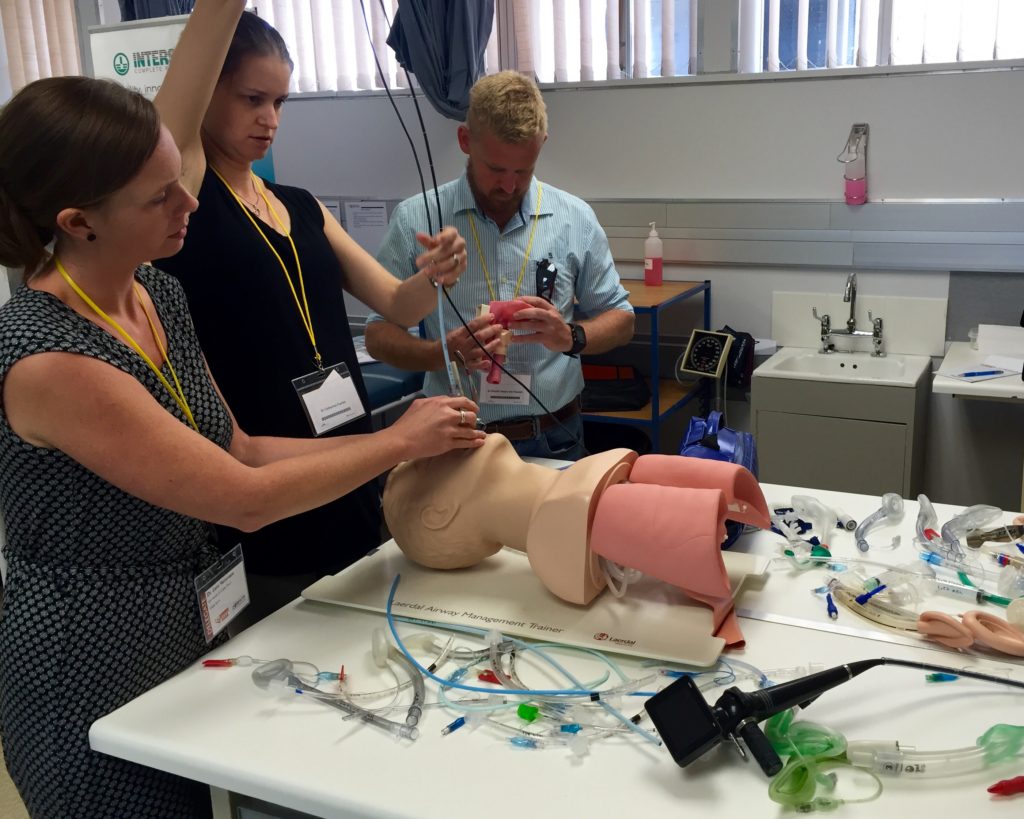While not exclusively airway themed, this talk for the #badEM symposium in September 2016 addresses the concepts of making mistakes in medicine, and how to make them meaningful. badEM are a shining light in South African #FOAM, and I’m very grateful for the invitation to speak and share at their event. For more info and pearls from the talk, see their page here. The podcast is shared below.
All posts by Ross Hofmeyr
How to build a breathing, bleeding cricothyroidotomy simulator
Jean-Christopher Ozenne (@JCOzenne) of Gouvieux, France has generously published this great video on how to build “The Mustache” – a breathing, bleeding cricothyroidotomy simulator – using cheap and ubiquitous equipment. Can’t wait to try this one out…I particularly like the artistic touch. To paraphrase V himself: A cric trainer without bleeding is not a cric trainer worth having.
Bronchial blockers: EZ-Blocker
Herewith a quick tutorial on the use and placement of the bifurcated, dual-balloon ‘EZ-Blocker’ bronchial blocker. More videos on the DLT vs BB debate, the other blockers, and troubleshooting advice to follow. Comments welcomed as always!
#FOAM? SMACC? What?
If you’ve found OpenAirway by search or accident, and the concept of #FOAM (Free, Open-Access Meducation) is new to you, then you’ll find the following video enlightening. The SMACC (Social Media And Critical Care) meeting is the yearly gathering of #FOAM enthusiasts, although it’s spiritual home, arguably, is within the ether of the Internet. OpenAirway was proud to be represented at SMACC this year in Dublin – truly an opportunity to interact, connect and be inspired by the best minds in acute and critical care from all disciplines.
October Airway & Thoracics Skills Courses open for bookings!
The UCT Department of Anaesthesia & Perioperative Medicine in conjunction with OpenAirway is running the next set of airway and thoracic anaesthesia skills courses during October. Information and bookings are now available via the Courses page here. There are three back-to-back courses which build upon the skill sets:
- Core Airway Skills – Suitable for any medical practitioner who may need to perform airway management, especially in an emergency setting. This starts with the basics (such as airway assessment and face-mask ventilation) and covers everything up to airway rescue and surgical airways except fibreoptic intubation.
- AEIOU – “Airway Endoscopy for Intubation and Other Uses” is for practitioners wanting to master videolaryngoscopy, learn the use of rigid intubating scopes and rigid bronchoscopy, and learn fibreoptic skills, including awake fibreoptic intubation.
- Thoracic Anaesthesia Skills – Designed as a primer or refresher for anaesthetists who want to perform lung isolation and one-long ventilation, this course covers important topics like the physiology of OLV, lung separation and isolation techniques, practical uses of double-lumen tubes and bronchial blockers, and the approach to the thoracic patient with a difficult airway.
Co to the courses page for more information and to book a place!
Basic fibreoptic/flexible scope skills video
Another quick training video, on the basic techniques of driving a flexible scope (fibreoptic or video) for intubation. This was made specifically as a primer for people in our own department taking part in a training study, but hopefully it is useful to a larger audience!
Please put your comments and (hopefully constructive) critique below. As always, you’re welcome to use with attribution!
Cape Town FCA2 Refresher: DAS 2015 Guidelines
Here’s the excellent simulation/re-enactment video from Simpact on the Elaine Bromiley Case that I featured in the lecture.
You can download my accompanying lecture notes on the DAS 2015 guidelines here:
FCA2 Refresher 2016 Notes – Hofmeyr – Difficult Airway Society 2015 Guidelines
Frerk et al’s article on the 2015 guidelines is available from the BJA here (open access), and the excellent recent editorial on front-of-neck access by Timmerman, Chrimes and Hagberg is here. This is not in the notes, as it has only just been published online.
The links to the different algorithms are on the Algorithms page, or you can browse the DAS website.
The surgical airway technique video that woudn’t play is below.
Video: Surgical cricothyroidotomy (DAS 2015)
Quick overview of the surgical cricothyroidotomy technique as presented in the 2015 Difficult Airway Society guidelines. This is simply presenting the technique in a manikin model, not intended as a debate about the relative merits of needle vs. surgical, blade vs. hook, scalpel-finger-bougie vs. scalpel-bougie-tube, etc!
Don’t forget to wear your PPE (gloves, mask, eye protection) and appropriately secure the tube afterwards.
As always, constructive criticism and suggestions for improvement are always welcomed in the comments section.
Video: Aintree intubation technique
Technique for using the Aintree Intubating Catheter (AIC) to exchange between a supraglottic airway (SGA) and endotracheal tube (ETT). This is typically required when an airway has been ‘rescued’ with an SGA that is not designed for direct intubation, with a narrow internal diameter or obstructions. The Aintree has a length of 55cm, internal diameter of 4.8 mm (not 4.2 as stated in the video) and external diameter of 6.0 mm, allowing a paediatric fibrescope or flexible intubating vide endoscope (preferably 4 mm or less) to be passed through the AIC, into the trachea, and then an ETT railroaded after removal of the SGA over the AIC. If that sounds confusing, watch the video!
Tips/tricks/advice/critique? Leave a comment!
The Difficult Airway Society (DAS) have a nice poster guide to help you remember how to do this – click the image below to open/download. (Open access).

Video: Flexible endoscopic intubation through SGAs
A description of the technique for intubating through a supraglottic airway that offers a sufficiently large internal bore to allow an appropriate-sized endotracheal tube using an adult fibreoptic or flexible video endoscope. Take note of the method of providing ventilation during the endoscopy!
As usual, this is an unscripted video, and constructive critique is welcomed to help us improve the educational offering.
